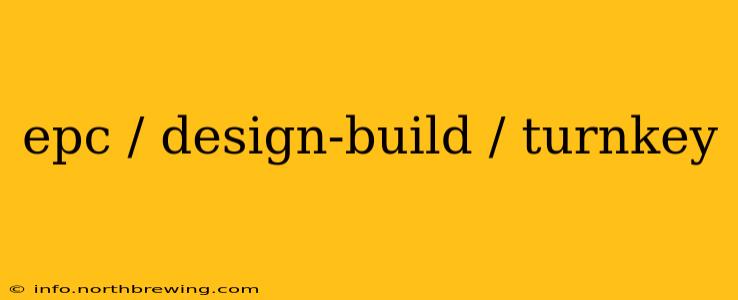The engineering, procurement, and construction (EPC), design-build, and turnkey project delivery methods are frequently used in large-scale construction projects. While they share similarities, understanding their key distinctions is crucial for project success. This comprehensive guide will clarify the nuances of each method, highlighting their advantages and disadvantages.
What is EPC (Engineering, Procurement, and Construction)?
EPC contracts consolidate the engineering, procurement, and construction phases under a single contractor. The client provides the project's scope and specifications, while the EPC contractor takes responsibility for designing, procuring materials, and constructing the facility. This streamlined approach simplifies project management for the client, offering a clear point of contact and accountability.
Advantages of EPC:
- Simplified project management: A single point of contact for the entire project lifecycle.
- Reduced risk: The EPC contractor bears responsibility for design and construction risks.
- Faster project completion: Streamlined processes can accelerate project timelines.
- Cost certainty (potentially): A fixed-price contract can offer budget predictability, although this isn't always the case.
Disadvantages of EPC:
- Higher upfront costs: The contractor's fees often encompass all project phases.
- Less client control over design: The client's input might be limited once the design phase begins.
- Potential for disputes: Disagreements can arise regarding design specifications or unforeseen circumstances.
What is Design-Build?
In design-build, a single entity is responsible for both the design and construction of a project. This entity, often a joint venture of a design firm and a construction company, works collaboratively with the client from the initial conceptualization through completion. This integrated approach fosters better communication and coordination between design and construction teams.
Advantages of Design-Build:
- Improved communication and collaboration: The single entity facilitates seamless communication and reduces potential conflicts between design and construction teams.
- Faster project delivery: Concurrent design and construction processes can shorten project timelines.
- Increased innovation: The collaborative nature encourages creative solutions and efficient design.
- Cost savings: Early involvement of the construction team can lead to cost-effective design choices.
Disadvantages of Design-Build:
- Potential for design compromises: The need for quick decisions might compromise some design aspects.
- Risk allocation: Clearly defining and allocating risks between the client and the design-build firm is crucial.
- Finding the right team: Selecting a competent and reliable design-build firm requires careful evaluation.
What is Turnkey?
A turnkey project is delivered fully completed and ready for operation. The client provides the project requirements, and the contractor handles everything else, including design, engineering, procurement, construction, commissioning, and even initial operation and training. The project is "handed over" ready to operate, much like turning a key to start a car. This is often considered the most comprehensive project delivery method.
Advantages of Turnkey:
- Complete project responsibility: The contractor handles all aspects, minimizing client involvement.
- Simplified project management: The client receives a fully functional facility without operational concerns.
- Predictable costs (potentially): Fixed-price contracts are common, leading to budgetary certainty.
- Faster project completion: Streamlined processes can ensure quicker delivery than other methods.
Disadvantages of Turnkey:
- Limited client control: Clients have minimal control over the design and construction processes.
- Higher initial investment: The cost encompasses all project aspects, potentially higher than other methods.
- Potential for unforeseen costs: Change orders can be costly and complex.
What are the Key Differences Between EPC, Design-Build, and Turnkey?
While all three methods aim for efficient project delivery, their scope and level of client involvement differ significantly. EPC focuses on the technical aspects, design-build integrates design and construction, and turnkey encompasses the entire project lifecycle, leaving minimal responsibility for the client. The optimal choice depends on the project's complexity, the client's experience, and risk tolerance.
Which Method is Right for My Project?
The best method for your project depends on several factors:
- Project complexity: Simple projects might benefit from a design-build approach, while complex projects might require an EPC or turnkey approach.
- Client expertise: Clients with limited construction experience might prefer a turnkey approach, while experienced clients might prefer more control with EPC or design-build.
- Budget: The budget will influence the choice of delivery method, considering the upfront costs and potential for change orders.
- Risk tolerance: Clients with lower risk tolerance might opt for EPC or turnkey to minimize potential liabilities.
Careful consideration of these factors will help determine the most suitable project delivery method to ensure success. Consulting with experienced project managers and contractors is recommended for making an informed decision.
